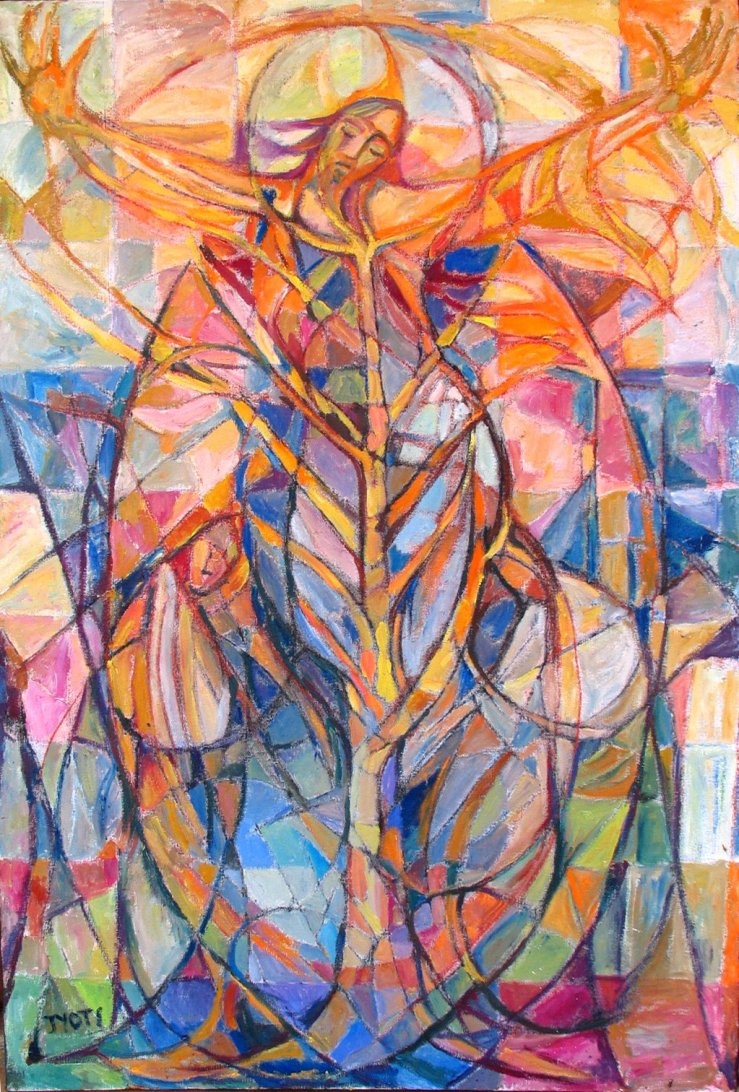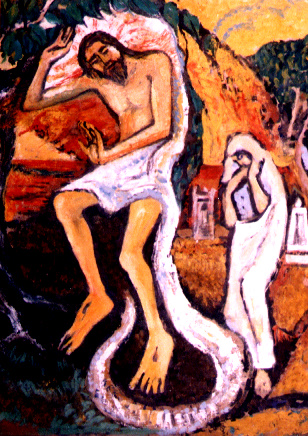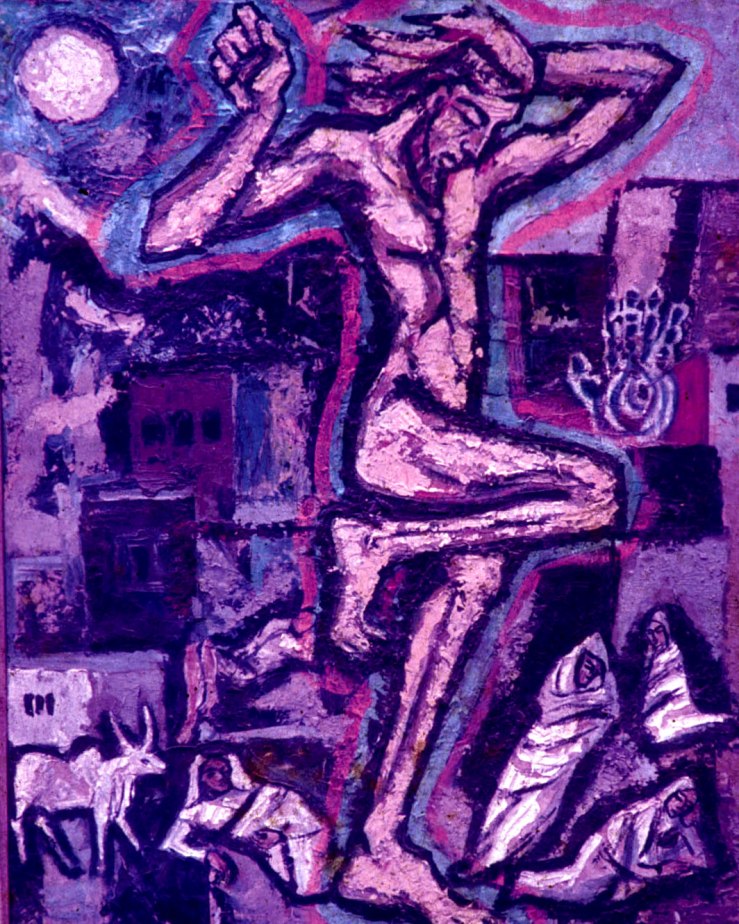The chocolate bunnies and plastic grass may have moved to the out-of-sight discount racks of stores, but Easter isn’t over! Because the Resurrection is a truth that’s not easily plumbed or quickly exhausted, the liturgical calendar designates fifty days for its celebration, a season known as Eastertide. In this period we are invited to linger over the gift of Jesus’s Resurrection—to spend time admiring it and becoming familiar with it and letting its power infuse our lives. So through May 14, the content at Art & Theology will focus on this bright season.
First up: three Resurrection paintings by Jyoti Sahi, who runs an art ashram in Silvepura Village, Karnataka, in India, just outside Bangalore. Of all the painters of biblical themes active today, Sahi is definitely one of the most inventive. An artist since the late 1960s, he has been instrumental in developing a visual gospel language that’s contextualized to Indian culture and in fostering Hindu-Christian dialogue. Here are three different approaches he’s taken to depict that notoriously difficult-to-depict subject: the Resurrection of Christ.
Jesus as the Greater Jonah
This is an example of an image that rewards deep looking, being so chock-full of symbols. I encourage you, before reading on, to just gaze at the image for one full minute, and see what you see.

First I notice the outstretched arms of Christ—a pose that deliberately references the Crucifixion. Here, though, those extremities are not pinned down to a cross. They are utterly open and free, embracing the world in risen glory. It’s common for artists to hint at the Crucifixion in Resurrection images. There’s a theological reason for that: the Crucifixion and Resurrection are two sides of the same coin, one great unified event, neither of which can be understood in isolation from the other. Sahi strengthens this link by including a human figure on each side of Christ. In Crucifixion images, these spots are traditionally occupied by the Virgin Mary and the apostle John, but here the abstracted figures double as two of the Marys at the tomb. They look down to where they had laid the body two days ago but find only an empty stone bench. They have yet to encounter the enormous presence behind them.
Next I notice the trunk of a tree that runs vertically up the center of the picture plane, almost one with Christ, whose arms stretch out like branches. The Tree of Life is a common motif in Christian art, a reference to John’s vision of heaven (Revelation 22:1–4). It is often integrated into Crucifixion imagery to prophesy hope in an otherwise bleak scene, but here the tree shoots forth from the ground in full-fledged resurrection power.
Upon closer examination, one can see that the tree branches double as the skeletal structure and gaping mouth of a fish. Christ is being expelled from this giant sea creature, much in the manner of the prophet Jonah. Jonah disgorged is one of the earliest Christian images of the Resurrection. It can be found painted on the walls of the third-century catacombs of Rome, where Christians were buried, and carved onto marble sarcophagi, and later it found its way into illuminated manuscripts, both Western and Eastern. The association of the Old Testament story of Jonah with the New Testament story of Jesus is one that Jesus made himself. When the Pharisees asked him for a sign to prove his messiahship, he said that he would give them none except the sign of Jonah. “For just as Jonah was three days and three nights in the belly of the great fish,” he said, “so will the Son of Man be three days and three nights in the heart of the earth” (Matthew 12:40). As the apostle Paul later articulated, Jesus’s Resurrection, his bursting forth out of the belly of the earth on the third day, has implications on the afterlife of believers. Because Jesus has risen from death to live eternally with God, so shall we. That’s why the earliest images of Jonah were created in funerary contexts. They provided hope for the loved ones of the deceased.
One other emblem worthy of notice is the almond-shaped mandorla in the upper register. A manifestation of God’s glory, the mandorla is usually shown rotated another ninety degrees, enveloping Christ’s whole body. What Sahi has done with this unique positioning is make possible additional readings of the shape. At first I saw it as the all-seeing eye of God, with Christ’s head forming the pupil, and a halo the iris. But it could also be the opening of a womb, from which the reborn Christ is emerging.
Resurrection ecdysis

This Resurrection painting of Sahi’s isn’t as much of a visual feast as the previous one, but that’s because it narrows in on a single metaphor: a snake shedding its skin, an act known as ecdysis. Here Jesus sloughs off his grave clothes, for they can no longer contain him. The skin of death—now just an empty casing—is discarded by the wayside.
This sloughing is a picture, too, of what the believer does when he enters into life with Christ: he sheds the old man, replacing it with the new (Ephesians 4:22–24). Like the snake that wriggles out of its restrictive epithelium to give way to a newer, larger, brighter layer of skin, so the Christian drops his or her old, familiar sin covering to sport a newer, brighter sheath: Christ himself.
In Sahi’s image, Mary Magdalene stands humbly by, a witness to this transformation.
Jesus as Lord of the Dance

In He Who Steps Over—The Tandavan, Sahi draws on Hindu iconography to give us a dancing Christ whose movement over death supplies the primal rhythmic energy of the universe. The whole world now pulses with resurrection potential!
Nataraja, Sanskrit for “Lord of the Dance,” is one of the embodiments of the Hindu god Shiva. As Nataraja, Shiva dances the Ananda Tandava (“Dance of Bliss”), which destroys ignorance and illusion and creates new life. Sahi has painted Jesus in the traditional Nataraja pose in the context of the Transfiguration and the Crucifixion, but here he modifies the pose to capture in particular Jesus’s crossing over to the other side, from death to life. Because he has crossed over, we can too.
The stylized hand in the background forms the abhaya mudra, a ritual gesture in Hinduism and Buddhism that says, “Fear not.” These assuring words of protection and peace are spoken many times throughout scripture by God and his messengers, including Jesus. Jesus’s Resurrection is the ultimate assurance that we need not fear death.
For more on Jesus the Nataraja, see my 2012 Jesus Question blog post “Jesus the Dancer, Part 2: The Art of Jyoti Sahi” and the brief article “Gott tanzt – Jesus Christus, der Nataraja” on the website of the German missionary organization Missio.

[…] (Related post: “Three Resurrection paintings by Indian artist Jyoti Sahi”) […]
LikeLike
Are prints available for these paintings? They are so beautiful and complex. I would love to have the first one to frame and hang in my home.
LikeLike
Unfortunately there are no prints available, but for now, Jyoti grants permission to print out the image for personal use (for tips on high-quality printing, see http://www.creativebloq.com/print-design/giclee-printing-11121324). He says the first painting was bought by the German organization Missio and that they printed it on a calendar several years ago–perhaps they have old copies available for sale. You could try contacting them at http://www.en.missio.com/.
I also learned from Jyoti that as he worked on the painting, he had in mind the Transfiguration, the two figures who bear witness to Christ being Moses and Elijah.
LikeLike
Hello! I don’t suppose you have any contact info for the artist? I work for a church and we would love to purchase rights to use the image for Easter.
LikeLike
I do, actually. (I get so many inquiries about these images!) You can reach Dr. Sahi at jyoti.inscape@gmail.com.
LikeLike
[…] Jyoti Sahi, Resurrection, […]
LikeLike
[…] a trip to Bangalore, India, later this month, to meet an artist whose work I admire, Jyoti Sahi [previously]. I apologize for being slow to respond to emails lately, but I do appreciate each and every […]
LikeLike
[…] “He who steps over” by Jyoti Sahi see Feature Article Rev. Sarah Van Zetten Bruins will be preaching at Trinity on February 6. Paul reminds the […]
LikeLike